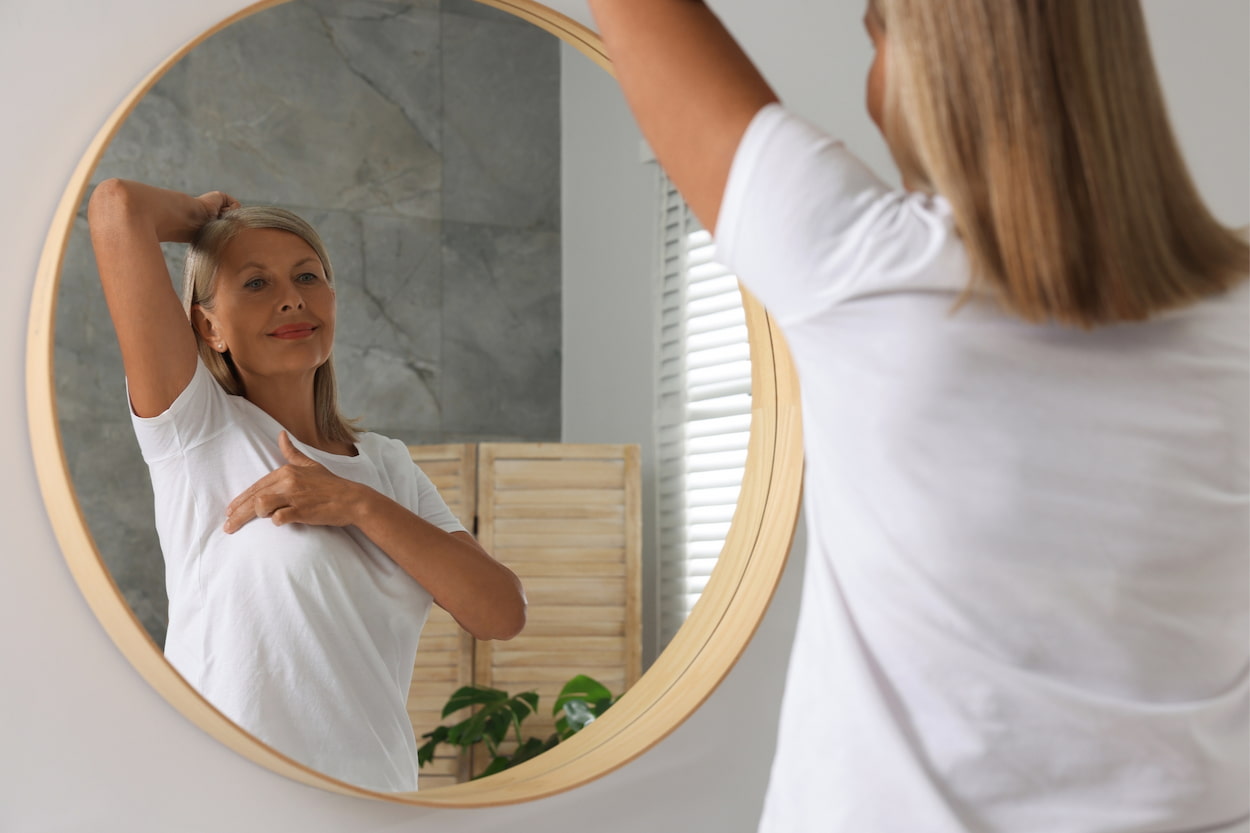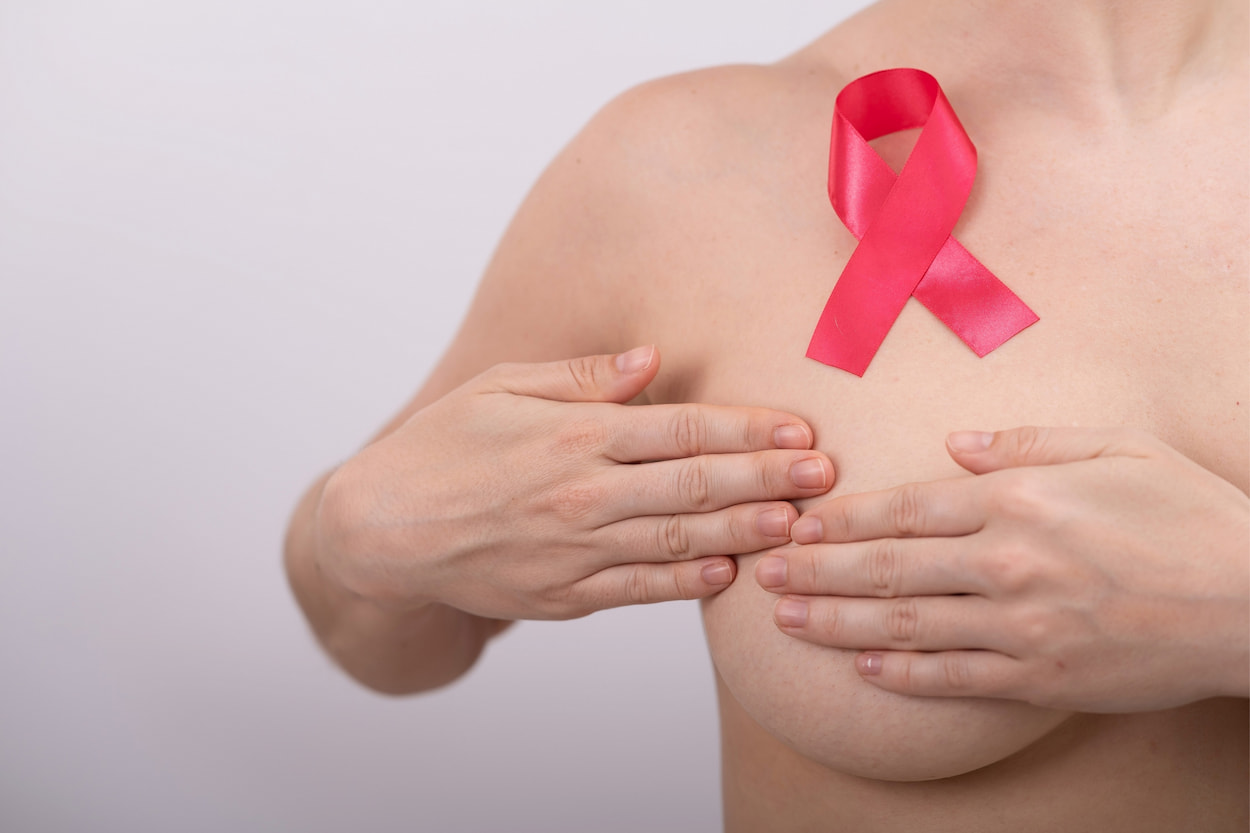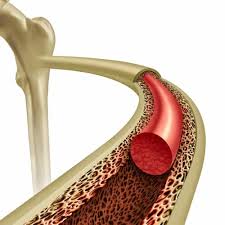
Breast Self-Exam
Breast self-examinations help you become familiar with how your breasts feel and appear so you can notify your healthcare provider if there are any changes. Mammograms can help you find cancer before you feel a lump.
About Breast Self-Exam
Breast self-examination, or routinely checking your own breasts, can be a significant approach to detecting breast cancer early when it is more likely to be effectively treated. The likelihood of early diagnosis is increased by completing a breast self-exam in conjunction with other screening techniques, according to many people, even if no single test can identify all breast cancers early.
Experts in medicine have disagreed at times throughout the years over the value of breast self-examination in identifying breast cancer early and boosting survival rates. For instance, a 2008 research of almost 400,000 women in China and Russia found that breast self-examination does not significantly affect the survival rates of breast cancer and may even be harmful because it leads to the unneeded removal and inspection of suspicious tissue (biopsies).
The American Cancer Society ceased advising breast self-examination as a screening method for women with an average risk of breast cancer in response to this study and others like it. Still, at Healthy Türkiye we recognize that breast self-examination can be a valuable and important screening tool, especially when combined with:
Regular physical exams by a doctor
Ultrasound, MRI (magnetic resonance imaging), or both
Each of these screening instruments operates differently and has advantages and disadvantages. You can incorporate breast self-examination as a convenient, free tool into your overall breast cancer screening plan on a monthly basis and at any age.
Why Is Breast Self-Exam Important?
Every woman, at every stage of life, should perform a monthly breast self-examination (BSE) as part of their overall health care. You can perform this physical examination in the comfort of your own home. Self-examinations allow women to identify changes in their breasts on their own, making this a crucial health habit to cultivate. Women should get routine breast exams by their healthcare professionals in addition to BSE. Beginning at age 40, women should undergo a mammogram every year. It has been demonstrated that carrying out these actions

How Should a Breast Self-Exam Be Performed?
Breast Self-Exam In the Shower: Check the entire breast and armpit area by pressing down with light, medium, and firm pressure using the pads/flats of your three middle fingers. Every month, feel both breasts for any lumps, thickening, knotting that has become hard, or other breast changes.
Breast Self-Exam In Front of a Mirror: With your arms on your sides, look over your breasts. Next, extend your arms far above your head. Keep an eye out for any changes to the nipple’s shape, any skin swelling or dimpling, or any changes to the contour. Next, squeeze strongly to contract your chest muscles while placing your palms on your hips. Few women’s breasts are perfectly symmetrical from left to right, so look for any dimpling, puckering, or alterations, especially on one side.
Breast Self-Exam Lying Down: Breast tissue distributes uniformly throughout the chest wall when lying down. Position a cushion beneath your right shoulder and your right arm behind your head. Move the pads of your fingers around your right breast softly, covering the entire breast area and armpit with your left hand. Light, medium, and hard pressure should be used. Examine the nipple for discharge and bumps. Rep the procedure for your left breast.
Who Should Do a Breast Self-Exam?
Doctors may advise people with a strong family history of breast cancer to begin monthly self-exams at 20. You can keep doing it for the rest of your life, even during menopause and pregnancy. Breast cancer can affect anyone with breast tissue, but studies of cisgender people (those whose gender identity matches the gender assigned at birth) suggest that women are 100 times more likely to have it than men. Breast cancer can also affect:
Men who are transgender. Doctors recommend yearly mammograms beyond the age of 40 if you haven’t had top surgery (subcutaneous mastectomy) to remove breast tissue. Between tests, you can perform breast or chest self-exams. If you’ve had breast augmentation or hormone therapy, self-exams can help you learn what your “new normal” looks and feels like so you can be on the lookout for any changes.
Women who are transgender. Using estrogen or progestin-based hormone therapy for 5 years or more increases your risk of developing breast cancer. In this scenario, doctors advise getting a mammogram every two years after the age of 50. Breast implants do not raise your chances of developing breast cancer, although they can make mammography more challenging. Breast self-exams, on the other hand, can help you adjust to your new body and look for changes.
Nonbinary individuals. Nonbinary people who were born with female reproductive organs and have not undergone top surgery should follow cis women’s screening recommendations. If you had breast tissue removed, ultrasounds or targeted MRIs may be required instead of mammograms.
Men. If you’re a cis guy and breast cancer runs in your family, consult your doctor about whether a monthly self-exam is necessary. Breast cancer is more likely in men between the ages of 60 and 70.
Why Should You Do Breast Self-Exams?
Monthly breast self-exams can assist you in detecting changes that could indicate an infection or breast cancer (such as breast lumps or spots that feel different). When breast cancer is found early, the odds of survival improve dramatically.
Self-examinations are critical for breast health. However, they should not be used in place of doctor-recommended checkups and screening procedures (such as mammograms). You should continue to see your primary care physician and/or gynecologist on a regular basis.
What to Do If You Find a Lump in Breast Self-Exam?
Many women experience lumps or changes in their breasts, as some of them are typical changes that occur at various stages of the menstrual cycle. A change or lump in your breast is not caused for concern. Breasts frequently feel different in different locations. A hard ridge along the bottom of each breast, for example, is normal. Your breasts’ appearance and feel will change as you age.
Make an appointment with your doctor if you observe any of the following:
A hard lump or knot under your arm
Changes in the appearance or feel of your breasts, such as thickening or apparent fullness that differs from the surrounding tissue
Dimples, puckers, bulges, or ridges on your breast skin
A recent modification in a nipple causes it to be pushed in (inverted) rather than jutting out
Heat, redness, swelling, or pain
Itching, scales, blisters, or rashes are all symptoms of a skin condition.
Nipple discharge with blood
Your doctor may recommend the following additional tests and treatments to investigate breast changes:
Diagnosing or ruling out cancer: A lump or breast change may not be cause for concern. Seeing your doctor is the only way to find out for sure what’s wrong. To diagnose or rule out cancer, your doctor may take the following steps:
Clinical breast exam: By palpating (feeling) the deeper tissue in your breasts and armpits, your doctor visually analyzes your breasts for changes and checks for lumps or thickening.
Diagnostic mammogram: If screening mammography or physical exam reveals anything unexpected, a diagnostic mammogram is usually ordered. This specialist mammography shows the problem area from multiple perspectives and at a higher magnification than normal screenings. This aids in determining the position and size of the lump.
3D mammogram: 3D mammography also known as tomosynthesis, provides a three-dimensional image of the breast tissue, allowing the radiologist to evaluate the breast tissue one layer at a time. It is very useful when inspecting dense breast tissue.
Breast MRI: Breast MRI (magnetic resonance imaging) is frequently used to assist evaluate the degree of breast cancer in women who have previously been diagnosed. An MRI, in addition to yearly mammography, is indicated for certain.
Ultrasound: An ultrasound creates images of the inside of your breast using sound waves. These photographs demonstrate whether a breast lump is solid or fluid-filled. Cancer treatment in Turkey can be operated also in solid masses.
Breast biopsy: Your doctor may take a tissue sample from the lump to look for malignant cells under a microscope. Only about 20% of biopsied breast tissue
The Study of Breast Self-exam
A comprehensive study conducted by the National Cancer Institute, involving a large sample of women across various demographics, reaffirmed the importance of breast self-exams in early breast cancer detection. The study revealed that breast self-examinations are a valuable tool when used in conjunction with other screening methods like clinical breast exams and mammography. Early diagnosis remains a critical factor in improving the chances of successful treatment and survival for breast cancer patients.
This study underscores that, despite the debates within the medical community regarding the effectiveness of breast self-exams, they continue to serve as a crucial and accessible aspect of breast cancer screening, empowering women to monitor their breast health and promptly report any changes to their healthcare providers.
Follow-Up Care After You’ve Found A Lump
If the results of your tests show that your lump is not malignant, your doctor may advise you to have another clinical breast exam or diagnostic mammography in a few months to check for changes. A benign, noncancerous tumor may nevertheless require surgery to be removed.
If the lump is malignant, you and your doctor can collaborate to design a treatment plan,” Dr. Wilde explains.
The options for breast cancer treatment in Turkey differ depending on the stage and type of cancer. If you have a strong family history of breast cancer, discuss genetic screening for breast cancer gene mutations with your doctor.
Healthy Türkiye Notes
A monthly breast self-exam will assist you in maintaining breast health and detecting early signs of illness. You can add breast inspection steps to your daily routine, such as when getting ready for bed or taking a shower. You will become more acquainted with your body with each breast self-exam. You’ll be more aware of changes when you know what’s normal for you.
Breast cancer awareness services, including breast cancer screening, are provided by many hospital clinics and healthcare provider offices. You may assist your healthcare team in maintaining your breast health by performing a breast self-exam once a month. If you would like to learn more about breast self-exam and breast cancer procedures and determine the best option for your unique needs, schedule a consultation with our board-certified doctors.



